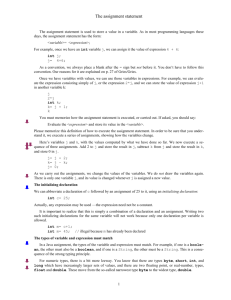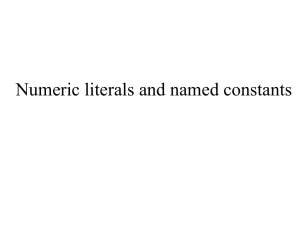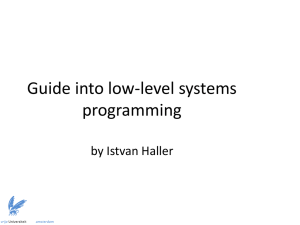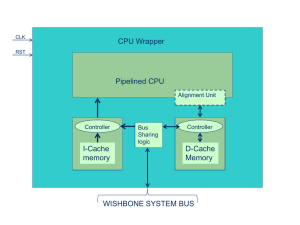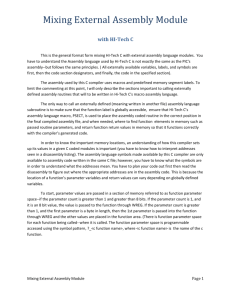Integer and Floating Data Types
advertisement
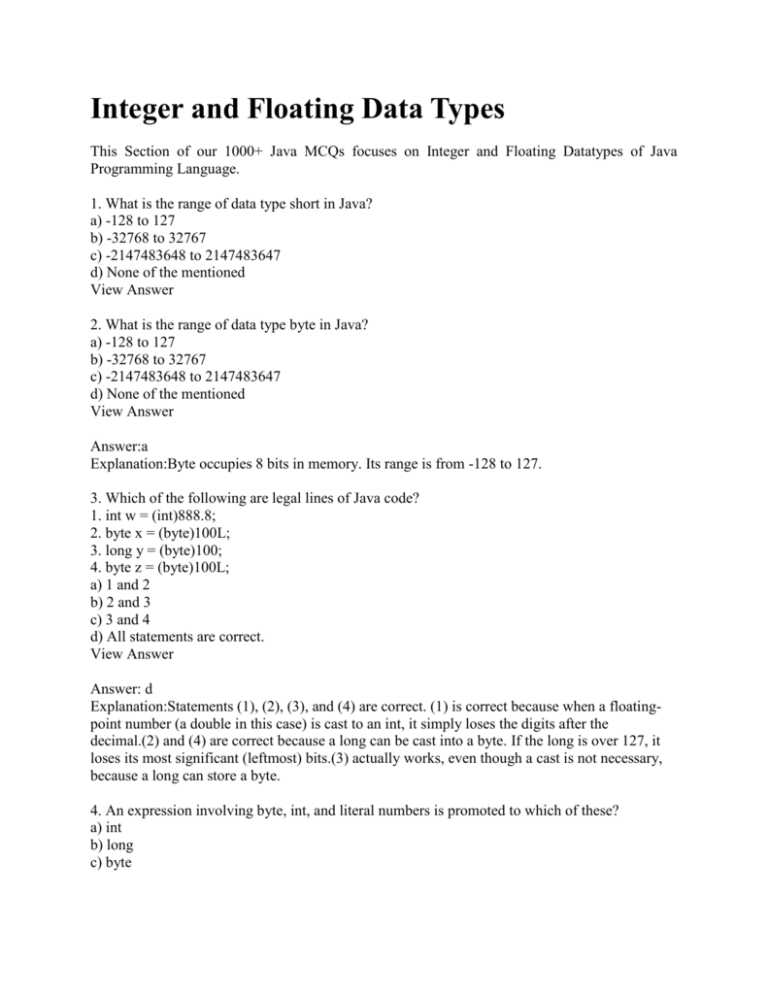
Integer and Floating Data Types
This Section of our 1000+ Java MCQs focuses on Integer and Floating Datatypes of Java
Programming Language.
1. What is the range of data type short in Java?
a) -128 to 127
b) -32768 to 32767
c) -2147483648 to 2147483647
d) None of the mentioned
View Answer
2. What is the range of data type byte in Java?
a) -128 to 127
b) -32768 to 32767
c) -2147483648 to 2147483647
d) None of the mentioned
View Answer
Answer:a
Explanation:Byte occupies 8 bits in memory. Its range is from -128 to 127.
3. Which of the following are legal lines of Java code?
1. int w = (int)888.8;
2. byte x = (byte)100L;
3. long y = (byte)100;
4. byte z = (byte)100L;
a) 1 and 2
b) 2 and 3
c) 3 and 4
d) All statements are correct.
View Answer
Answer: d
Explanation:Statements (1), (2), (3), and (4) are correct. (1) is correct because when a floatingpoint number (a double in this case) is cast to an int, it simply loses the digits after the
decimal.(2) and (4) are correct because a long can be cast into a byte. If the long is over 127, it
loses its most significant (leftmost) bits.(3) actually works, even though a cast is not necessary,
because a long can store a byte.
4. An expression involving byte, int, and literal numbers is promoted to which of these?
a) int
b) long
c) byte
d) float
View Answer
Answer: a
Explanation:An expression involving bytes, ints, shorts, literal numbers, the entire expression is
promoted to int before any calculation is done.
5. Which of these literals can be contained in a data type float variable?
a) 1.7e-308
b) 3.4e-038
c) 1.7e+308
d) 3.4e-050
View Answer
Answer: b
Explanation:Range of data type float is 3.4e-038 to 3.4e+308.
6. Which data type value is returned by all transcendental math functions?
a) int
b) float
c) double
d) long
View Answer
Answer:c
Explanation:None.
7. What is the output of this program?
1.
2.
3.
4.
5.
6.
7.
8.
9.
10.
11.
12.
class average {
public static void main(String args[])
{
double num[] = {5.5, 10.1, 11, 12.8, 56.9, 2.5};
double result;
result = 0;
for (int i = 0; i < 6; ++i)
result = result + num[i];
System.out.print(result/6);
}
}
a) 16.34
b) 16.566666644
c) 16.46666666666667
d) 16.46666666666666
View Answer
Answer:c
Explanation:None.
output:
$ javac average.java
$ java average
16.46666666666667
8. What is the output of this program?
1.
2.
3.
4.
5.
6.
7.
8.
9.
10.
class conversion {
public static void main(String args[])
{
double a = 295.04;
int b = 300;
byte c = (byte) a;
byte d = (byte) b;
System.out.println(c + " " + d);
}
}
a) 38 43
b) 39 44
c) 295 300
d) 295.04 300
View Answer
Answer:b
Explanation:Type casting a larger variable into a smaller variable results in modulo of larger
variable by range of smaller variable. b contains 300 which is larger than byte’s range i:e -128 to
127 hence d contains 300 modulo 256 i:e 44.
output:
$ javac conversion.java
$ java conversion
39 44
9. What is the output of this program?
1.
2.
3.
4.
5.
6.
7.
a) 25
b) 24
c) 32
class increment {
public static void main(String args[])
{
int g = 3;
System.out.print(++g * 8);
}
}
d) 33
View Answer
Answer:c
Explanation:Operator ++ has more preference than *, thus g becomes 4 and when multiplied by
8 gives 32.
output:
$ javac increment.java
$ java increment
32
10. What is the output of this program?
1.
2.
3.
4.
5.
6.
7.
8.
9.
10.
class area {
public static void main(String args[])
{
double r, pi, a;
r = 9.8;
pi = 3.14;
a = pi * r * r;
System.out.println(a);
}
}
a) 301.5656
b) 301
c) 301.56
d) 301.56560000
View Answer
Answer:a
Explanation:None.
output:
$ javac area.java
$ java area
301.5656
